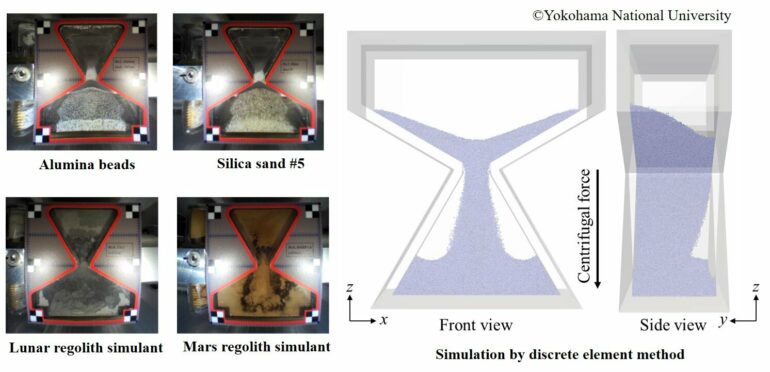Running on the beach versus a paved road can change an athlete’s stride, speed and stability. Alter the force of gravity, and that runner may break their personal record or sink into the ground. Researchers have to consider such parameters when designing extraterrestrial rovers and landers—which can trawl where no person has stepped foot.
To better inform this work, a multi-institutional team analyzed the flow of simulated regolith, a type of fragmental debris that covers the moon and rocky planets, using an artificial gravity generator on the International Space Station.
They published their work in npj Microgravity.
“Studying the flow characteristics of regolith covering extra-terrestrial bodies under low gravity condition is essential for the reliable design and analysis of landers and rovers for space exploration,” said corresponding author Shingo Ozaki, professor at Yokohama National University. “Regolith, which is a potentially fluffy and powdery granular material, is a primary concern for the lander or rover; landing on such loose soil is a critical phase during exploration as the footpad of the landing gear may bury into the regolith.”
Spirit, one of the twin rovers that landed on Mars in 2004, fell victim to regolith six years into its mission. Its wheel became irrevocably stuck in regolith, forcing its termination.
“This issue clarified the importance of wheel-soil interaction mechanics,” Ozaki said. “These mechanical interaction models of machines—such as the landing gear or mobility system—on such granular media under various levels of gravitational acceleration are key to their reliable design and analysis.”
In this study, researchers proposed an experimental approach to examine how various gravity conditions influence how eight sands, including simulated regolith, behave over hours. Prior experiments performed for shorter durations of mere seconds demonstrated that flow dynamics of granular media depend on the gravitation acceleration.
However, according to Ozaki, the experimental facilities were not equipped to test the flow dynamics for longer periods of time. For that, they needed to be in space—specifically at the International Space Station (ISS).
There, specially designed hourglass containers were placed in the ISS’s Japanese Experimental Module, which is equipped with a centrifuge that can provide long-term, stable artificial gravity conditions. Each container housed simulated regolith or sands found on Earth, Mars or the moon. Over seven hours, the researchers applied various artificial gravity conditions to the containers and studied how the granular materials flowed through the narrow neck of hourglass shape.
“The artificial gravity condition in the experiment was confirmed to be reasonable to study the gravity-dependent flow of granular media,” Ozaki said. “We then found that the flow characteristics of some sands quantitatively follow well-known physical laws, even at low gravity.”
The researchers also confirmed that bulk density, or how compact a granular material is, of sand decreases with gravity. In other words, with less gravity, sand becomes fluffier—and potentially more dangerous for vehicles.
Next, the researchers said they plan to investigate the competitive behavior between the gravity and adhesive forces acting on sand particles under low-gravity conditions.
“The characteristics of the gravity-dependent flow and bulk density of sand can be used as a basis for a mechanical model and parameter set necessary for predicting the interaction between machines and regolith under low gravity,” Ozaki said, explaining that such information would provide the foundational information needed to better predict how surface media behavior may influence interactions with vehicles.
More information:
S. Ozaki et al, Granular flow experiment using artificial gravity generator at International Space Station, npj Microgravity (2023). DOI: 10.1038/s41526-023-00308-w
Provided by
Yokohama National University
Citation:
Exploring how to build better extraterrestrial robots (2023, September 26)


